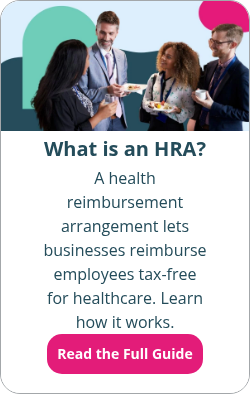Five tips to start offering employees health benefits
By Holly Bengfort on March 17, 2025 at 9:45 AM
Growing your business is an exciting milestone. Hiring talented employees who can help you reach your company’s goals is a key part of that success. If you want to keep your talent, you need to offer a competitive health benefits package. Choosing the right health benefits can boost retention and job satisfaction.
But, offering benefits can feel overwhelming. Where do you start with an employee health plan? How do you know which plan is right for your employees? Can you find a plan that fits your budget? To help you answer these questions, we’ll give you five tips on how you can start offering health benefits to your employees.
In this blog post, you’ll learn:
- The benefits of offering employee health plans, such as improved retention and tax advantages.
- The various comprehensive health benefit options for small to mid-sized businesses.
- Key considerations for implementing a health benefit, including cost analysis and regulatory compliance.
Tip #1: Understand the value of offering health benefits
One question that may be on your mind when considering offering health benefits for the first time is: Is it worth it? In short—absolutely. Our 2024 Employee Benefits Survey Report found that 92% of employees value having employer-sponsored health benefits.
When employees have access to affordable healthcare, they'll:
- Be more engaged at work
- Take fewer sick days
- Be more productive in helping your company reach its goals
According to a Gusto survey, small employers that offer health insurance are 25% more likely to say their employees work better than expected compared to companies without health benefits1.
If that wasn't enough, let's review a few more advantages of employee health plan coverage below.
Recruit and retain key employees
Employee health benefits are valuable in recruiting key workers and retaining talented employees. Forbes found that 67% of employees and 68% of employers believe employer-covered healthcare is the most important benefit in 20242. This isn’t surprising as it remains the most sought-after employee benefit plan year after year.
Our Benefits Survey also found that 81% of potential employees believe an employer’s benefit package is a critical factor in whether they accept a job offer. So, if you're not offering a health benefit, you may have difficulty hiring the candidates you want. Your current employees may also start looking for better opportunities at other companies.
Tax advantages
Depending on the type of health or medical plan you offer, you can benefit from tax savings. Employees can also save on taxes by participating in the benefit.
Health reimbursement arrangements (HRA) are particularly advantageous. For employers, HRA reimbursements are free of federal payroll taxes. Employees are also exempt from paying income taxes on HRA reimbursements. With other types of benefits, like group health insurance, your employees can also pay their premiums on a pre-tax basis.
Employee wellness
Finally, offering health insurance keeps employees healthy and working. The more accessible and robust your health benefits package is, the less your employees need to take time off work to manage a critical illness or other health concerns. Lower absenteeism rates allow your organization to be more productive and profitable.
Employee wellness programs and benefits don’t only include physical medical conditions. Having a comprehensive health benefit also helps your employees have more affordable access to the mental healthcare they need. This can help them better manage stress and avoid burnout.
Tip #2: Analyze the risks and costs of offering health benefits
Now that you know why offering health benefits is so important, your next step is to consider the risks and costs of your available options.
Like any new expense for your organization, investing time to research your choices is key to finding a plan that meets your needs.
Cost
Health insurance costs will vary depending on the type of coverage you choose. For example, group health plan premium costs typically rise annually. The uncertainty of these rate renewals can make financial planning difficult for small businesses. This can make cost-controlled options, including HRAs and health stipends, more attractive.
Administrative commitment
Next, you'll need to consider how much time and effort it will take to administer your health benefit. If you can't commit the resources to manage the benefit, it likely won't succeed.
With a traditional plan, your administrator will choose the medical coverage, fill out forms, remit premiums, and act as an intermediary between your employees and an insurer, broker, or both. This can significantly drain your resources if you have a small team or budget.
An HRA reduces administrative time, especially if you use an HRA software solution like PeopleKeep by Remodel Health. We offload the most tedious tasks and offer compliance assistance, allowing you to manage the benefit in minutes per month.
Tip #3: Research your employee health benefit options
After reviewing the costs and risks, it's time to examine your employee health coverage options more closely. You might think health insurance policies are a luxury only larger organizations can offer. But this is far from the truth.
There are three main types of health benefits available to small employers. Let's review them in more detail below to help you make an informed decision.
Traditional group health insurance
The traditional approach to employer-sponsored health coverage is a group plan. But, this type of coverage can be expensive for employers and limiting for employees.
These plans are generally uniform, offering the same coverage for employees and their family members. This means all full-time employees fall under the same umbrella of care, regardless of their unique healthcare needs. Group health insurance plans are also tied to an individual's employment, and they’ll only have a few plan options to choose from.
Most organizations are likely familiar with this type of comprehensive health coverage. But, it isn’t always the best option. Because of steep participation requirements and annual rate hikes, many small to midsize organizations seek more flexible alternatives.
Stand-alone health reimbursement arrangements (HRAs)
You can contribute to your employee's healthcare costs with an HRA. HRAs are formal health benefit plans that allow employers to reimburse their eligible employees, tax-free, for qualifying medical expenses.
IRS Publication 5023 and the CARES Act4 have the complete list of eligible items. However, you can choose to limit eligible expenses to premiums only during your HRA plan design.
Some examples of HRA-eligible expenses include:
- Doctor visits
- Over-the-counter medicine
- Prescriptions
- Mental health counseling
- Chiropractic care
The most significant advantage of a stand-alone HRA is the ability to reimburse employees for individual health insurance premiums.
Rather than paying an insurance company for a group plan, you can offer your employees a monthly allowance to buy the medical services and items that work best for them. Because you choose your own HRA allowance, you can rely on fixed costs every month and year. Unlike health savings accounts (HSAs), HRA funds stay with the employer when an employee leaves the organization.
Your employees can choose their own individual health insurance plan, giving them control over their level of coverage. This makes an HRA a great way to empower your workers while still providing a quality health benefit plan.
Learn more about the two most popular types of HRAs:
- The individual coverage HRA (ICHRA) is an excellent option for businesses of all sizes. There's no annual limit with an ICHRA, so employers can offer as much monthly allowance as they want. You can also provide differing reimbursement amounts to different employee classes, such as seasonal and salaried workers. Participating employees must have a qualifying form of individual coverage.
- Employers with 50 or more full-time equivalent employees (FTEs) subject to the Affordable Care Act's (ACA) employer mandate can opt for an ICHRA over group coverage.
- The qualified small employer HRA (QSEHRA) is for employers with fewer than 50 FTEs. While they have maximum contribution limits, the QSEHRA allows employers to reimburse employees for insurance premiums and out-of-pocket medical expenses. You must offer the benefit to all full-time W-2 employees. But you can choose to allow part-time workers to participate, too.
- All employees must have an insurance policy with minimum essential coverage (MEC) to use the benefit.
Taxable health stipends
Some small business owners simply give employees extra money for their medical care expenses. By bumping their staff’s pay, they avoid spending time choosing and administering a formal health plan.
But there's a better way. If you want increased flexibility, offering a taxable health stipend is an excellent choice. A health stipend works like an HRA, where you give your employees a fixed amount of money to help them pay for their insurance premiums and medical expenses, including supplemental plans. However, HRAs are only available to W-2 employees. If you have 1099 contractors and international workers, a stipend can support everyone’s needs.
Stipends aren’t a formal health benefit, so they may not work for every company. For instance, a stipend doesn't satisfy the ACA's employer mandate for organizations with 50 or more FTEs. You'll also miss out on the tax savings other health benefits, like HRAs, offer. Employers must pay federal payroll taxes on stipends, and employees are subject to income taxes.
However, health stipends are great options for organizations with employees who receive advance premium tax credits. Your employees can continue receiving their subsidy and using their stipend without affecting their eligibility.
Tip #4: Work with a broker
Next, if you find the health insurance industry challenging to navigate, work with a trusted insurance agent or broker. Licensed agents and brokers are professionals knowledgeable about health benefits for small and mid-sized organizations. They can help you navigate your options and choose the right health coverage at the best price when things get confusing.
Tip #5: Understand how healthcare regulations impact your organization
Finally, it's vital to understand healthcare rules and regulations and know which ones apply to your situation. Below are two healthcare reform regulations every organization should know:
Minimum essential coverage (MEC)
Under the ACA, MEC is any type of medical insurance that meets the individual shared responsibility requirement, also known as the individual mandate.
When Congress introduced the ACA, Americans who didn't satisfy the individual mandate faced a tax penalty. But, as of 2019, the IRS no longer enforces the individual mandate or penalty on a federal level. This means your employees don't have to have a policy that meets MEC unless they live in one of the six states still requiring it.
While the federal government no longer demands individuals to have MEC, the ICHRA and the QSEHRA require employees to have MEC.
Employer mandate
Offering health insurance is mandatory for some organizations. Applicable large employers (ALEs) or employers with 50 or more FTEs must offer their employees affordable healthcare with MEC that meets minimum value.
ALEs who fail to offer an affordable plan that meets minimum value or MEC to at least 95% of their full-time employees may have to pay a penalty if at least one full-time employee buys a health plan using premium tax credits. These are known as the employer shared responsibility provision (ESRP) penalties. The mandate and penalties don’t apply to your organization if you have fewer than 50 FTEs.
But, the ACA doesn’t require ALEs to provide group health insurance. An ICHRA can help you satisfy the employer mandate if your employees have individual health coverage that meets minimum value and your HRA allowance is affordable.
Conclusion
Offering your employees health benefits for the first time is an exciting achievement that should make you proud. Choosing the right health benefit will help your company flourish and give you peace of mind, knowing you're doing the right thing for your staff.
If you're ready to offer your employees personalized health benefits, PeopleKeep by Remodel Health can help! Our HRA administration software helps employers set up and manage their health benefits without the headache. Schedule a call with an HRA specialist today to see how an HRA can boost your employee benefits package!
This blog article was originally published on May 13, 2014. It was last updated on March 17, 2025.
1. Gusto’s 2024 State of Small Business Survey
2. Forbes' Best Employee Benefits
4. CARES Act
Check out more resources
See these related articles

How your employee benefits package can foster inclusivity
Discover how an inclusive benefits package can foster workplace inclusivity. Learn which benefits support diversity and meet employee needs.

What is healthcare reimbursement?
Looking to reimburse your employees for their healthcare expenses? Learn everything you need to know about healthcare reimbursement.

HRAs and W-2 annual reporting
Learn about HRA W-2 annual reporting requirements. Understand what employers need to include on employees' W-2 forms for HRA compliance.



